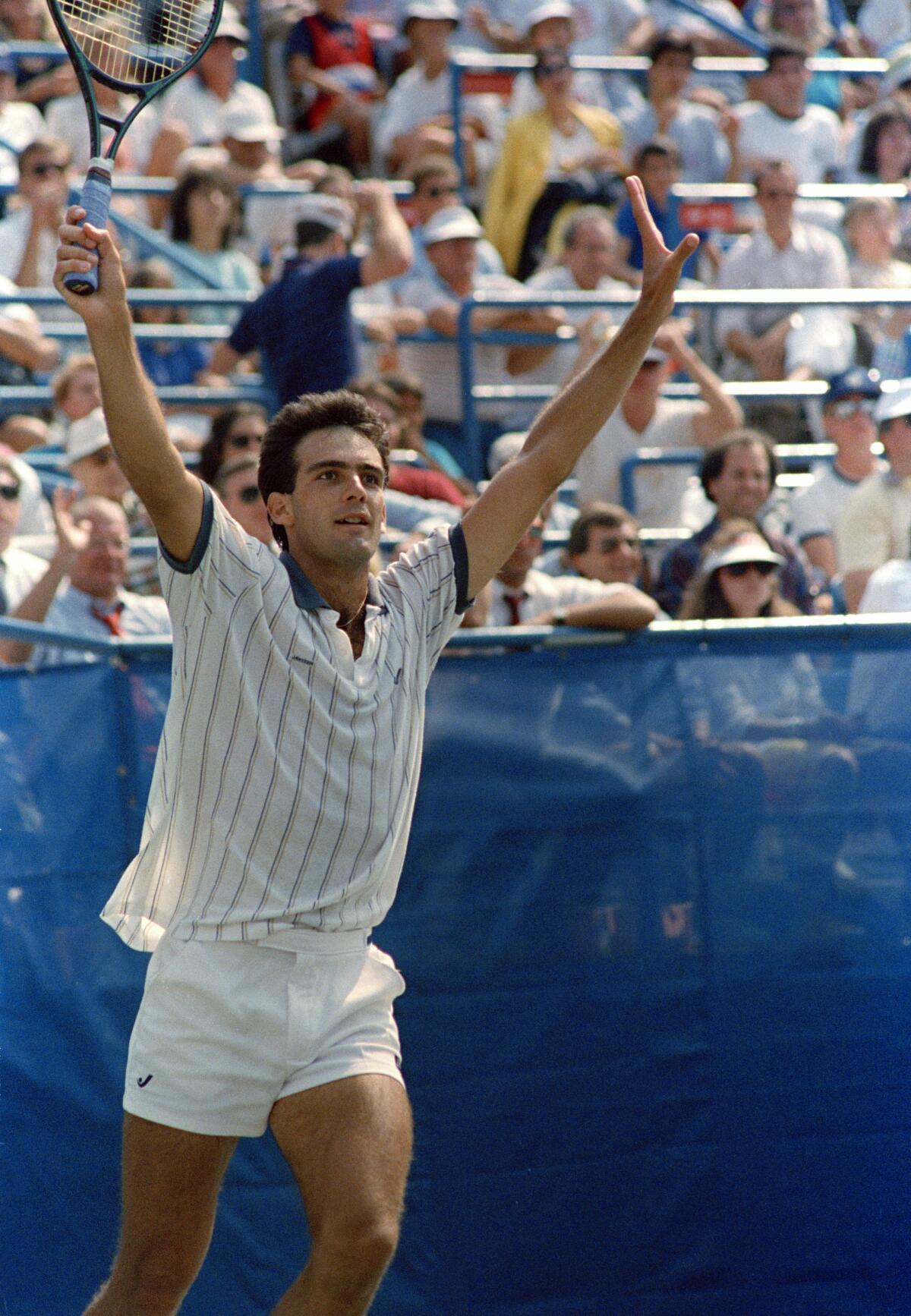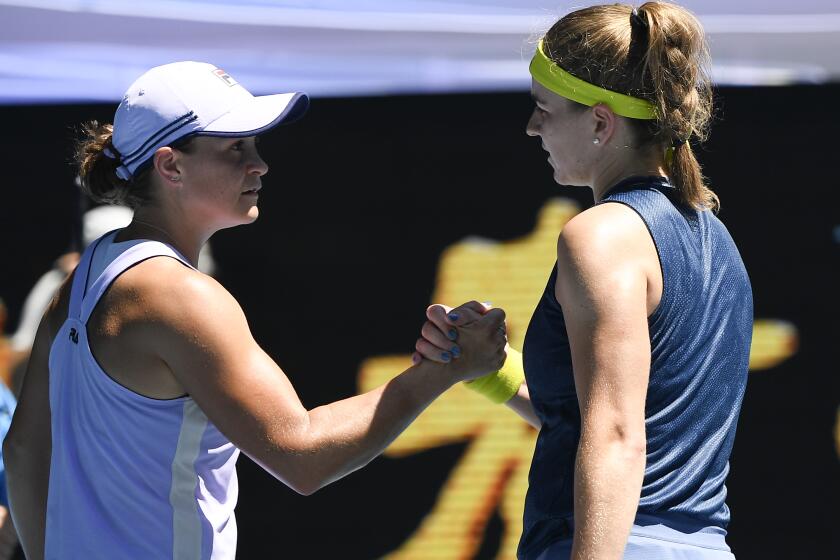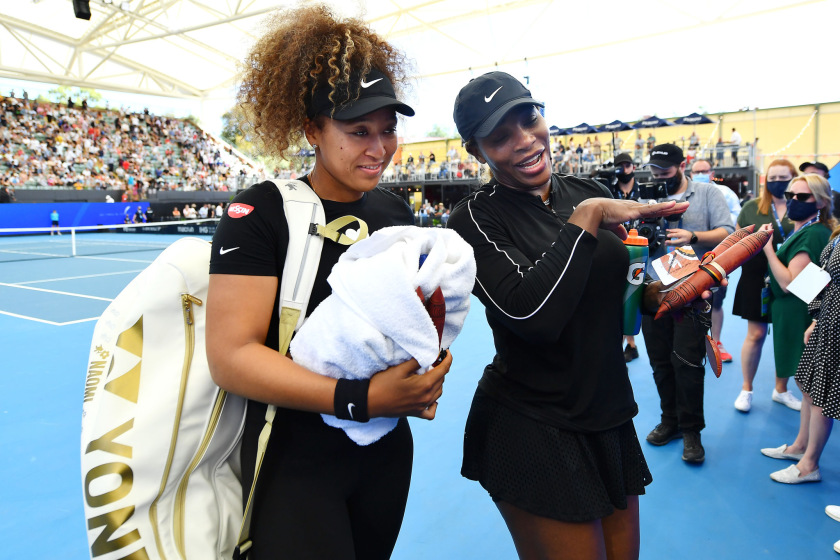Column: Paul Annacone wants to help put U.S. men’s tennis back on right track

- Share via
Paul Annacone is eminently qualified to understand the disappointing absence of American men from the upper echelons of men’s tennis rankings and to recognize that the way to help players realize their potential is through wide collaboration starting at the local level.
Annacone, who reached a peak singles ranking of No. 12 in the world in 1986 and won the 1985 Australian Open men’s doubles title with Christo van Rensburg, coached Grand Slam singles champions Pete Sampras and Roger Federer and now works with Taylor Fritz of Rancho Palos Verdes. Fritz, 23, did well to reach the third round of this year’s Australian Open, where he lost in five sets to world No. 1 Novak Djokovic.
The only American man to reach the second week was Mackenzie McDonald, who won the 2016 NCAA singles and doubles championships while at UCLA. McDonald lost his fourth-round match to No. 4 seed Daniil Medvedev in straight sets, continuing American men’s futility in major events. American women are thriving, but no American man has won a Grand Slam singles title since Andy Roddick triumphed at the 2003 U.S. Open.
“Back in the dark ages when I got off my dinosaur and played, I came along right as John McEnroe and Jimmy Connors were finishing. So I got to be ranked 12 in the world, and while I thought that was great for me, that’s not really kind of what the USA is looking for,” Annacone said in a recent phone conversation.
Top-ranked Ash Barty was upset by No. 25-seeded Karolina Muchova in the quarterfinals at the Australian Open. Mens No. 2 Rafael Nadal lost to Stefanos Tsitsipas.
“We’re looking for the legends. We’ve been spoiled with the [Andre] Agassis, Samprases, Jim Couriers, Michael Chang. Connors. McEnroe. We’ve had so many. After that, we had Andy Roddick come along and get ranked No. 1 in the world. I think it’s a very challenging environment right now, but that expectation is hanging over the young American men and the young American ladies as well.”
Annacone, who worked in player development for the U.S. Tennis Assn. as well as the Lawn Tennis Assn. in England and Tennis Australia, will have a chance to improve the environment for young players here as a new member of the player development staff of the Southern California section of the U.S. Tennis Assn. He will work with Trevor Kronemann, the director of junior tennis for the USTA Southern California, and Scott Lipsky, who played at Stanford and won a mixed doubles title at the 2011 French Open.
Annacone envisions creating a clearinghouse for players and coaches and, as COVID-19 permits, launching a college combine, holding clinics for promising young players starting at the 12-and-under level and bringing coaches together to pool their knowledge. He’d like to hold programs and clinics at clubs throughout Southern California.
The talent is out there. And the sport’s popularity has survived pandemic restrictions, probably because tennis is inherently socially distanced.According to a survey conducted by Sports Marketing Surveys and published in the Physical Activity Council’s Participation Report, participation in tennis increased by 22% in 2020.

“Southern California historically has had the best players in the United States and some of the best players in the world, and they still do,” Annacone said. “Everyone’s kind of looking for the holy grail, but there really isn’t one. It’s a lot of hard work.”
Because he spent eight years working with Sampras and four with Federer, he has often been approached by parents who say they want their kids to be the next Sampras or Federer. That’s not likely.
“The idea is to take their habits,” Annacone said. “What does Roger do so well? Forget about winning matches. What is the program that’s allowed him to be successful? What is Sampras’ program? What has Serena [Williams] done? Take the program that maximizes those skills and then plug the attributes that are relevant to the players who are doing it here and now. You’re not all of a sudden going to make them as gifted as Roger or Serena, but there’s a lot of commonalities in the way they train and what they do that will help all these players maximize their skill set.”
For players like McDonald and former UCLA standout Jennifer Brady — who reached the U.S. Open semifinals last year and defeated Jessica Pegula in the Australian Open on Wednesday to move into the semifinals — tennis was a formative experience and a solid springboard to a pro career. For others, college tennis will be as far as they go. Annacone wants to help them too.
Williams and Osaka will face off during normal waking hours in an Australian Open semifinals that’s been described as a Brady-Mahomes-like showdown.
“There’s not one way to be a professional player,” he said. “And even if kids aren’t going to be professionals, I feel like it’s a really healthy environment and a really tremendous resource for the staff at the SCTA to be able to say, ‘Here’s what’s out here for Sally or Johnny. They’re currently ranked 18 in the section. They’re 15 years of age. Here are some ideas about how and where they should play,’ and then try to educate parents and kids about college pathways and scholarships, where the good programs are, where the good educations are. So I think it’s a pretty broad-stroke comprehensive theme about just being a resource that helps the kids maximize their talent, whatever that level is.”
Most of his work is still in the planning process. As the COVID-19 vaccine becomes more widely available and health regulations ease, he hopes to be able to hold age-group camps in the next few months and stage the college combine in June. “After living through 2020 we’re just in challenging times, and I think any person that’s going to be successful in these challenging times better be flexible, better be able to pivot,” he said, “and that’s what we’re trying to do right now. It’s going to take some time.”
Lacking a holy grail, a solid and realistic plan seems the best course.
More to Read
Go beyond the scoreboard
Get the latest on L.A.'s teams in the daily Sports Report newsletter.
You may occasionally receive promotional content from the Los Angeles Times.













